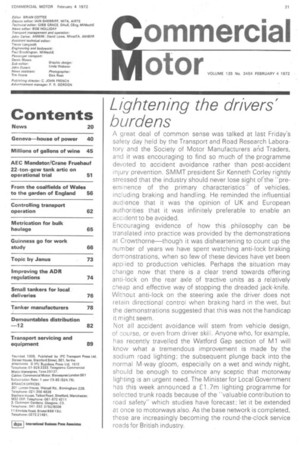Lijhtening the drivers' burdens
Page 23

If you've noticed an error in this article please click here to report it so we can fix it.
A great deal of common sense was talked at last Friday's safety day held by the Transport and Road Research Laboratory and the Society of Motor Manufacturers and Traders, and it was encouraging to find so much of the programme devoted to. accident avoidance rather than post-accident injury prevention. SM MT president Sir Kenneth Corley rightly stressed that the industry should-never lose sight of the "preeminence of the primary characteristics.' of vehicles, including braking and handling. He reminded the influential. audience that it was the opinion of UK and European authorities that it was infinitely preferable to enable an accident to be avoided.
Encouraging evidence of how this . philosophy can be translated into practice Was provided by the demonstrations at Crowthorne—though it was disheartening to count up the number of years we have spent watching anti-lock braking demonstrations, when so few of these devices have yet been applied to production vehicles. Perhaps the situation may change now that there is a clear trend towards offering anti-lock on the rear axle of tractive units as a relatively cheap and effective way of stopping the dreaded jack-knife. Without anti-lock on the steering axle the driver does not retain directional control when braking hard in the wet, but the demonstrations suggested that this was not the handicap it might seem.
Not all accident avoidance will stem from vehicle design, of course, or even from driver skill. Anyone who, for example, has recently travelled the Watford Gap section of M1 will know what a tremendous improvement is made by the sodium road lighting; the subsequent plunge back into the normal M-way gloom, especially on a wet and windy night, should be enough to convince any sceptic that motorway lighting is an urgent need. The Minister for Local Government has this week announced a EL 7m lighting programme for selected trunk roads because of the "valuable contribution to road safetywhich studies have forecast: let it be extended at once to motorways also. As the base network is completed, these are increasingly becoming the round-the-clock service roads for British industry.














































































































































